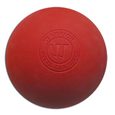 I'm not one to subscribe to a lot of toys or gadgets to provide treatment and help my clients reach their goals but I do get excited when I find one that works and works really well. Thanks to fellow physical therapist, Erson Religioso, I now have in my possession an excellent new tool, The Edge, that makes my job easier and more effective which is great news for my clients. It may not look like much (or it may frighten some people) but it is an excellent all around tool for Instrument Assisted Soft Tissue Mobilization (IASTM). As much as I enjoy using my hands, there are times when a tool or instrument can really be a huge advantage and difference maker. There are also some tissues in the body that fingers and hands simply cannot have as much of an impact on like metal or other hard objects can. Since The Edge is a 'Jack of all trades' with its variety of edges, it can be implemented in many ways depending on the specific needs of each client and situation. That means having the ability to match the appropriate edge for treatment and truly target the particular issue at hand. The beauty of it is just like many soft tissue techniques, it can be utilized for both prevention and/or treatment for injuries. Admittedly, it saves my hands for other treatments and techniques as well. With its versatility, The Edge can be used for a wide range of issues like tendonitis/tendinosis, muscle strains, trigger points, etc. It can be used for acute or chronic scar tissue formation especially following surgical procedures so that movement and mobility can be restored. Persistent or chronic muscle tightness (think calf and upper trapezius) tends to respond quite well to IASTM. Any type of restriction in connective tissue like the plantar fascia, iliotibibial band, and joint retinaculums are also prime candidates for tools like The Edge. As you can see, there are many applications for IASTM as it can be the perfect adjunct to other techniques and treatments to help you move better, feel better and live better. Sometimes it can the missing piece to help you get over the final hurdle that has been a challenge to get over otherwise. If you have any soft tissue issues or just want to stay ahead of the game with preventative treatment, don't miss out on this opportunity. It really can be a game changer! Knowledge = Power; Share The Power:
0 Comments
 Whether you've just completed the SOS Triathlon or you've been stuck at your desk all day, we could all use some soft tissue love periodically. Many of us don't have the time or money to devote to routine professional massage therapy sessions which is where a cheap, inanimate object becomes a great substitute: the lacrosse ball. If you're just introducing yourself to soft tissue mobilization or you're a bit tender from a grueling race, I prefer to use a soft or indoor lacrosse ball. Regular lacrosse balls can be a great option as well but there is always a time and place for each version. If you don't have access to a lacrosse ball just yet, start with a tennis ball and graduate up to a lacrosse ball when you can. Using body position and leverage you can take advantage of the shape and firmness of a lacrosse ball to address any tender spots, tightness, trigger points, etc. Addressing restrictions like these leads to better quality of movement which often means feeling better during your activities and with your recovery. Since the SOS Triathlon was this past weekend I wanted to share a few videos by Kelly Starrett that would demonstrate ways to utilize lacrosse balls for hot spots you may be dealing with after the race. That being said, these are by no means limited to triathletes and can be incredibly helpful for anyone. Enjoy! Areas around the thoracic spine and shoulder blade. If the floor is too difficult or uncomfortable, the same thing can be done standing and leaning against a wall. Areas around the anterior and posterior shoulder. Areas around the calf, knee, and hamstrings. There are a couple other alternatives to a lacrosse ball that you may like as well. Areas around the hip, glutes and psoas.
|
Dr. Greg Cecere
Your personal physical therapist, movement educator and knowledge dispenser. Newsletter Sign Up
Enter your name and email to get Momentum PT's Movement Manual delivered straight to your inbox! It's your free monthly newsletter and guide to moving better, feeling better and living better! Archives
April 2017
Categories
All
Disclaimer:
The contents of this blog is meant for educational purposes only. Momentum Physical Therapy of New Paltz and Dr. Greg Cecere are not responsible for any harm or injury that may occur due to any information on this blog as it is by no means a substitute for a thorough evaluation by a medical professional. |
|
Momentum Physical Therapy of New Paltz, PLLC. Copyright © 2013-2024. All Rights Reserved.
Disclaimer: The contents of this site is meant for educational purposes only and utilization of any of the material is a personal choice. Momentum Physical Therapy of New Paltz and Dr. Greg Cecere are not responsible for any harm or injury that may occur due to those choices. This site is by no means a substitute for a thorough evaluation and guidance by a licensed medical professional.
|
 RSS Feed
RSS Feed
